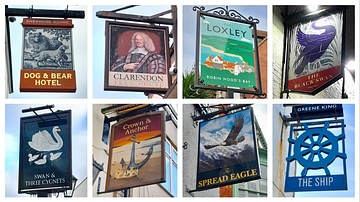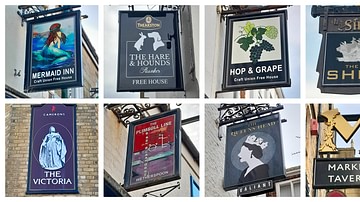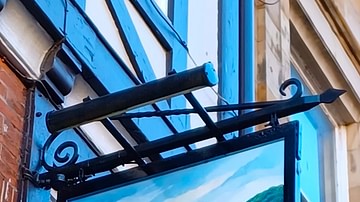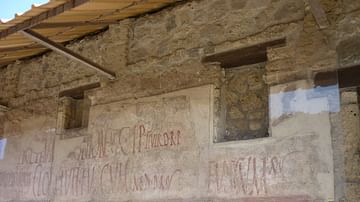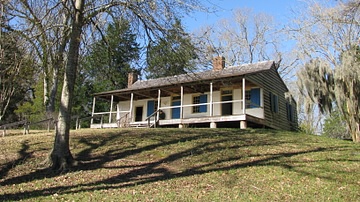Pubs remain a prominent feature of the rural and urban landscapes of Britain, but their names very often date back to medieval times. Red lions, white horses, and colourful characters peer from pub signs as landlords choose names to represent local history, legends, landmarks, national figures, or simply imply their drinking establishment has a long and prestigious heritage.
This article presents the meaning behind some of the most common pub names seen across Britain from Penzance to the Hebrides. According to The Wordsworth Dictionary of Pub Names, there were over 50,000 pubs in Britain at the beginning of the 21st century. The same source identifies the top 20 pub names. Red Lion, Crown, and Royal Oak are the top three, then (in alphabetical order) Anchor, Angel, Bell, Bull, Coach & Horses, George, George & Dragon, King's Head, Nelson, New Inn, Plough, Railway, Rose & Crown, Swan, Duke of Wellington, White Hart, and White Horse (269). As the appeal of pubs and inns has widened to other countries, many of the traditional British pub names can be seen today around the world from New York to Melbourne.
The pub names below have been selected because they are especially common, their meaning is obscure, or the history behind them is of particular interest. Self-explanatory but, nevertheless, very common names such as Hop & Grape, Jolly Sailors, or Duke of Marlborough are omitted for want of space. As shall be seen, many variations of a name are possible, even in broad meaning, but a local would always have known the precise significance of their pub's name since, from the late Middle Ages until the mid-19th century, when most of the population was illiterate, it was the pub's sign which gave the establishment its name (and not vice-versa, as is usually the case today). Pub signs, which were made obligatory by a 1393 law, can take the form of a painting, a representation in wrought iron, a three-dimensional model, or even a weather-worn example of the object itself.
Anchor
The name Anchor is, naturally, most popular by the coast where fishing traditions are strongest. However, the name was also common for pubs near canals, particularly overnight stops for barges carrying goods such as coal and wine between towns and cities. The name can be qualified by all sorts of adjectives related to seafaring such as Foul Anchor (used to rescue a ship in distress), Sheet Anchor (a ship's largest and most reliable anchor), and Raffled Anchor (an entangled anchor). For extra cachet, the name might be upgraded to Royal Anchor. A lesser-known significance of the name is when it is used in reference to Saint Paul who, in the Bible, mentions that faith is like an anchor and gives hope, hence the pub name Anchor of Hope. As the colour blue is symbolic of hope, pub signs for this name very often depict a blue anchor. Finally, there is the common variation Crown & Anchor, which refers to the arms of the Lord High Admiral and the badge of petty officers in the Royal Navy.
Bear
The fierce bear was a common symbol in medieval heraldry and so became a favourite of landlords. When the pub name refers to the animal, it is usually qualified by its colour such as Brown Bear or Black Bear. Bear-baiting, where a bear was tied to a post and set upon or 'baited' by one or more dogs, was a 'sport' commonly held in pub courtyards. Betting on how long or whether the dog or dogs would survive at all was an essential part of the activity. Pub names like Dog & Bear refer to this practice, which was outlawed in 1835. The name Bear & Ragged Staff (the post the bear was tied to) refers to the heraldic device of the Earls of Warwick and is mentioned in Henry VI Part Two by William Shakespeare (1564-1616). Bears were also used in travelling shows and by wandering handlers, where the animal was made to dance on its hind legs, hence the name Dancing Bear or Bear & Bell, the latter referring to the bell the bear wore around its neck. Bear's Head and Bear's Paw are common variations.
Bell
The name Bell has appeared on tavern and inn signs for centuries. Typically referring either to a church bell or handheld bell, ambitious landlords may add any number of them to their establishment's name so that one can find anything from Two Bells right up to Twelve Bells. The bells may be referred to more specifically, such as The Bells of Saint Mary, or the name could allude to those who make the bells ring, such as The Bell Ringers or The Ringer's Rest. Pubs by the sea might use a ship's bell on their sign while many signs might show a simple inscription on the bell, such as "Fear God, Honour the King". Combining pub names, like Star & Bell, has long been a common practice, perhaps to link a new landlord to their predecessor or to refer to a previously owned pub. Other links could be more logical such as animals that wear a bell. Common combinations with a bell include Bell & Bottle, Bell & Bullock, and Bell & Gate.
Black Friars
"Black friars" was a popular name for Dominican monks in the Middle Ages since their gowns were that colour. The cloistered world of monks and monasteries, having a long association with brewing beer, has often inspired pub names. The Dominicans, in particular, were regarded, rightly or wrongly, as being especially partial to beer. Names linked to medieval monastery life include specific monasteries like Fountains Abbey and generic names like The Priory, Monk's Head, Abbey Arms, Abbot's Mitre, Abbot's Fireside, Friar's Tavern, and Jolly Friar, which may refer to Friar Tuck from the Robin Hood legend (see "Green Man" below).
Bull
The powerful bull, prone to anger and charging was a popular heraldic emblem, and the animal appealed to many landlords in rural areas where bulls were a major asset. Variations include Black Bull (and any other colour you fancy, even blue), Bull's Head, Bull's Neck, Old Bull, and Bull & Butcher. Like bears, bulls were 'baited' for sport, hence the dog breed known as bulldog, and so Bull Ring, the arena where such activities were held, became a common pub name. The Ox is a common variation on the same theme, and famous examples sometimes earned a name for posterity, such as the Durham Ox, a specimen from Darlington that weighed in at a mighty two tons and toured the country to great astonishment and applause.

Cat & Fiddle
Cats appear in many pub names, perhaps most commonly the Black Cat since it traditionally represents good luck. The name Cat & Fiddle dates back to the 16th century and refers to the nursery rhyme "Hey diddle diddle/The cat and the fiddle". The sign of the pub so named often has the cat playing the fiddle, the informal name for a violin. Variations on the theme of cats include Cat & Bagpipes, Cat's Whiskers, and Cat's Eyes.
Coach & Horses
The name Coach & Horses became especially popular in the 17th century when stagecoaches provided a means of land travel over long distances. Regular stops were required along the route to change tired horses and give equally beleaguered coachmen and travellers a chance to refresh themselves. After several hours crammed in an irregularly bouncing coach, inns at staging posts often became more longed for than the ultimate destination of the voyagers. Variations of the name include Mail Coach (referring to the coaches that carried post as well as passengers from 1784 to 1846 before trains took over), Coach & Six (referring to the six horses pulling the coach), and even specific coaches famous for their speed and reliability, such as Red Rover (renowned in Northampton).
Cross Keys
The name Cross Keys derives from the arms of the Catholic Popes in Rome after the reference in the New Testament to Saint Peter receiving the keys to the kingdom of Heaven from Jesus Christ. Bishops whose diocese contained a major cathedral dedicated to St. Peter often carried the symbol in their arms, too. Keys, crossed or otherwise, were also a common feature of medieval heraldry.
Crown
The name Crown has been in common use since the 15th century and may have been used to imply some sort of royal connection, bolstering confidence amongst a pub's clientele. Loyalty to the reigning monarch may be another reason for its choice. The name Rose & Crown, which refers to the rose of the house of Tudor, has been in use since the early 17th century and more specifically symbolises loyalty to the monarchy. Common variations are Angel & Crown (reminding people that the monarchy reigns in God's name), Crown & Cushion (to remind of a coronation ceremony), Crown & Glove (in reference to a royal champion's gauntlet thrown down to challenge any disputers on Coronation Day), and Crown & Mitre (to remind of the necessity that the state and church remain in harmony). Finally, Three Crowns can refer to the Magi of the nativity of Jesus but also may simply reflect the pub sign painter's love of three objects, a number that fits nicely into the limited space available to them.
Fox & Hounds
The fox has been a popular animal in pub signs for five centuries since it is easily recognisable with its bushy tail and carries a connotation of cleverness. In rural areas, where the fox is a menace to poultry and other farm animals, pub names related to the hunting of foxes are more common. Fox & Hounds refers to the pack of dogs used to chase down a fox while the local gentry, dressed in scarlet coats, follow on horseback. The fox and its prey can be reflected in names like Fox & Hare, Fox & Rabbit, and Fox & Goose. More fox-friendly names include Crafty Fox, Hungry Fox, and Running Fox. Aesop's fable where a fox tries but fails to reach a bunch of grapes and then decides he does not want them anyway since they are sour is the source of the expression ‘sour grapes' (meaning a bad loser) and the common pub name Fox & Grapes.
Green Man
The name Green Man is one of the more flexible pub names. It may refer to the legend of Robin Hood and his followers who, wearing green, robbed the rich and gave to the poor from their lair in Nottingham Forest. It was not uncommon for pub signs in the past to bear a related motto or rhyme, designed to lure in travellers. Thus, a Green Man sign might carry the legend:
Ye gentlemen and yeomen good,
Come in and drink with Robin Hood.
If Robin Hood is not at home,
Then stop and drink with Little John.
(Hackwood, 311)
The name Green Man can, alternatively, refer to the much more ancient nature figure associated with forests and pagan rituals such as those celebrating May Day. A third meaning is the traditional profession of forester.

King's Head
The name King's Head is especially common with over 50 pubs in London alone. The sign may depict any male monarch, although clever landlords might have a different king on each side to broaden the appeal. Common alternatives include King's Arms, King's House, or, of course, Queen's Head. Anti-royalists came up with the rather unflattering witticism "If the King's Head is empty, the King's Arms are full" (Richardson, 53). Specific names of British monarchs are also common, as are names referring to fictional rulers like King Arthur and King Lear, or Queen of Hearts and King of Diamonds from playing cards. Foreign rulers crop up here and there, such as King of Prussia and King Canute. Even princes can be so honoured, particularly Black Prince, after Edward the Black Prince (1330-76), son of Edward II of England (r. 1327-77), and in more general names like Prince of Wales and Prince Regent. Finally, a royal visit to a pub often led landlords to thereafter place an appropriate coat of arms above their doorway as a sign of royal favour.
Plough
Used since the 16th century, the name Plough remains very common, particularly, of course, in rural areas. The name may be depicted visually by the constellation of that name, also called Ursa Major or 'Great Bear'. Common variations include Plough & Furrow, Plough & Horses, and, more recently, Plough & Tractor. The name Ploughshare refers to the blade of the plough. The name Plough & Shuttle refers to a farmer and his wife's division of labour, he in the fields and she at her spinning wheel. The name Plough and Sail refers to the agricultural implement which permits the start of the cultivation process and the windmill which finishes it with the production of flour.
Red Lion
Another very common name, the most popular of all, is Red Lion, which derives from the device widely used in medieval heraldry since first worn by John of Gaunt (1340-1399), founder of the House of Lancaster. Lions represent courage and strength, but their colour can vary as reflected in the popular names Golden Lion, Black Lion, and even Blue Lion, all heraldic devices. Red Lion can also represent Scotland and was widely used from the reign of England's first Scottish monarch, James I of England (r. 1603-1625), to bolster support for the change of ruling family from the Tudors to the royal house of Stuart.
Royal Oak
Probably the second most popular pub name after Red Lion, Royal Oak refers to the legend attached to Charles II of England (r. 1660-1685). The English Civil Wars (1642-51) resulted in the execution of Charles I of England (r. 1625-1649) and his son, future Charles II, was obliged, after the royalist defeat at the Battle of Worcester in September 1651, to flee for his life. Charles hid in an oak tree, the Boscobel Oak, for the rest of the day to escape capture, and so a new pub name was born, Royal Oak. Charles returned to England and his throne with the Restoration of 1660. The king's birthday, 29 May, was declared Royal Oak Day.
Ship
The Ship name is common in many a coastal town, the pub sign often being a real ship's wheel in the past, one of those easily recognisable signs necessary in the times when most people could not read. Variations include names of specific types of ship like Schooner, Frigate, and Galleon. Famous ships often find themselves on pub signs, particularly warships and those of explorers. Common examples include the Mary Rose, the flagship of Henry VIII of England (r. 1509-1547), and the Golden Hind of the circumnavigator Francis Drake (1540-1596).
Swan
The name Swan (sometimes using its antique misspelling Swann) may be seen alone or, with a colour such as White Swan or Black Swan (the older of the two). This elegant bird has appealed to landlords since the 14th century, although the name may also refer to the common heraldic device which was favoured by medieval knights, great landowners like the earls of Essex, and monarchs such as Henry VIII. Variations include the bird's habitat such as Swan & Rushes or refer to its offspring such as Swan & Three Cygnets. The not uncommon name Swan with Two Necks probably refers to the practice of marking a bird's beak with nicks to identify their owner and the word "nick", or "neckes", as it was once spelt, has been corrupted over time. Marking ownership was necessary since owning swans used to be a royal privilege, with Elizabeth I of England (r. 1558-1603) extending the right to favoured courtiers and companies.

White Hart
A hart is the male deer and the animal's antlers made it an easy sign to spot and remember. The name White Hart, one of the oldest, became widespread during the reign of Richard II of England (r. 1377-1399) since he used it as his personal emblem and insisted that his followers wear a version of it on their person. The name became so popular with landlords that 'White Hart' was even used as a generic name for any tavern in the 15th century.
White Horse
The name White Horse has been popular since the 15th century, although it may also be used in reference to the heraldic device which was popular with the ancient kings of Wessex and such houses as the Hanoverians. The name can also refer to a horse depicted on a hillside using chalk such as near Folkestone (the white horse being the traditional symbol of the county of Kent). There is, too, a connection with many guilds since the white horse appears in the arms of the Coachmen, Farriers, and Wheelwrights guilds, all professions necessary to the business of travelling by stagecoach when inns marked welcome stopover points. Variations are common, especially Black Horse (in use from the 14th century), and may refer to the sport of horse racing such as Galloping Horse, specific race winners like Blink Bonny (which won the 1857 Derby), or less glamorous working cousins like Shire Horse (the sturdy pulling horse), Pack Horse (widely used before the canals arrived), and Nag's Head (nag being a small pony, often for hire in old inns).




